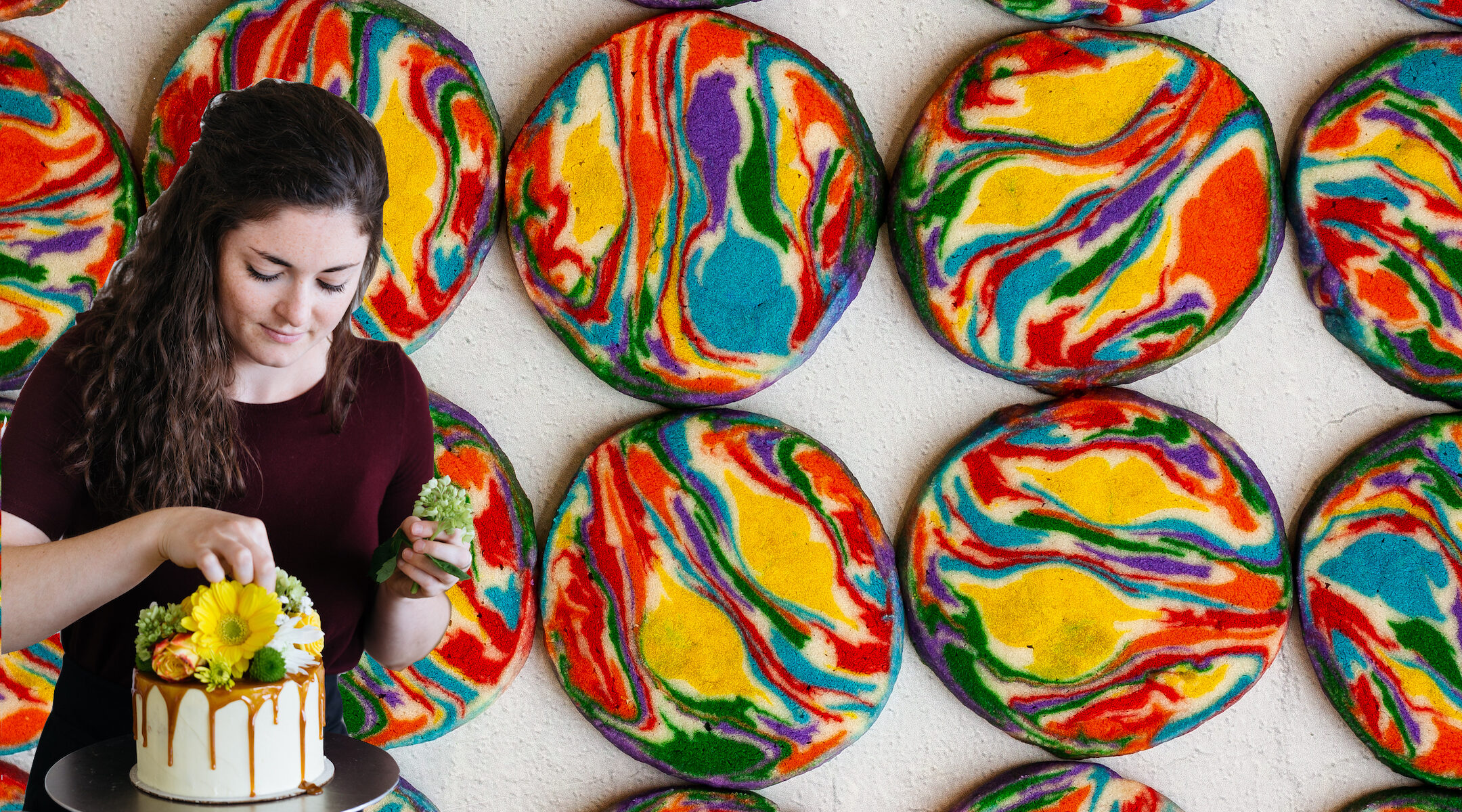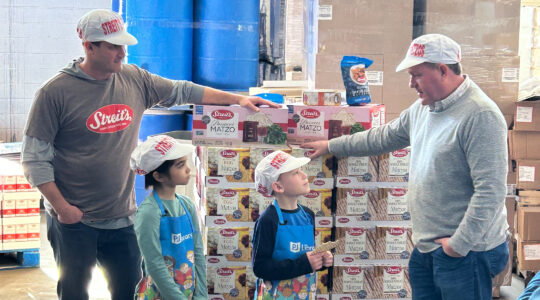(JTA) — For Elana Berusch, every season is cookie season.
Berusch, a Denver-based baker and food scientist, marked January by whipping up some pink-and-white cookies, in a bright twist on the classic Jewish deli treat; honored summer with a tart decorated to look like a watermelon; and celebrated Thanksgiving by baking pumpkin pie into a chocolate-chip dough.
Now, her kaleidoscope marbled shortbread is the cover cookie of the Washington Post’s holiday baking coverage, expanding Berusch’s influence far beyond the 30,000 followers of her Instagram account, Lani.Bakes. The photo accompanying the recipe shows two versions, one in a technicolor and another in a wintry red and green, and it’s been shared and replicated widely.
But don’t call them Christmas cookies. The 28-year-old Jewish baker, who grew up attending a synagogue that her family helped start in Cleveland, says she wants to subvert the centrality of the Christian holiday in winter baking.
“It’s been really nice to celebrate something other than Christmas with this cookie,” Berusch told the Jewish Telegraphic Agency. “It’s been nice to celebrate color and to celebrate playfulness and to celebrate variety in a way that isn’t about those traditions.”
Most of what Berusch bakes isn’t tied to any particular cultural tradition, but she has drawn on her own from time to time, such as when she created sufganiyot cupcakes with coconut “latkes” last month or shortbread using hamsa-shaped cookie cutters she bought in Israel.
And despite her misgivings, Berusch does lean into Christmas every once in a while, just as she did for Easter when she created a pavlova nest filled with fig chicks. (The project, she said at the time, reflected her “dessert happy place … the intersection of fun, delicious and colorful.”) Just last week, she posted a picture of an earl grey tea cookie decorated with sunflower-seed string lights.
“Yes I’m Jewish and Christmas isn’t my thing, but I love cookie decorating and Christmas is unfortunately unavoidable in December so here we are,” she wrote.
We spoke to Berusch about her marble cookie’s runaway success, what it’s like to be a Jewish baker at Christmas and the Jewish foods she’s thinking about reimagining in her signature style.
This conversation has been condensed and lightly edited for clarity.
JTA: How did the marbled shortbread cookies come about and why do you think they’re resonating so much?
EB: It really did start on a dare. So my friend Zach [Martinucci, the Jewish baker behind Denver’s Rebel Bread] and I were looking at a claywork video and I said, what if you could do this with cookie dough? Zach said, I bet you can. I’m always one for a fun challenge, so I gave it a whirl.
They always look like they’re going to be a huge disaster. The first time I sliced into them I literally laughed out loud because I did not expect it to work at all, definitely not to work as well as it did.
I think best when my hands are moving, and there’s something really calming and childlike about the process with these cookies — it does feel like play dough. That’s part of what makes it appealing to people: You go in knowing that you’re going to make a little bit of a mess but then you end up with something really beautiful, and it’s different every time. Because of that suspense factor, people make batch after batch after batch — I’ve already seen that happen.
What do you make of the fact that this winter’s viral cookie was made by a Jewish baker?
I kind of love it — because it’s not a Christmas cookie. I’ve had a couple of people interview me about my holiday cookie tradition. And I’ve had to push back and say, you need to be more careful about these questions because I don’t have Christmas cookie traditions. I don’t have gingerbread traditions. And I think that’s allowed me to be much more creative when it comes to what cookies can look like in this season.
I think there’s something really beautifully subversive about the biggest Christmas cookie of the year or whatever being developed by someone who does not celebrate Christmas, has no links back to holiday peppermint or gingerbread, or red and green or any of that.
I’m not trying to say that they should have Christmas cookies made by non-Christians, more that people need to dig deeper into the fact that not everybody celebrates Christmas and that Christmas trees are not secular, which is what people have told me repeatedly throughout my life.
I don’t think about it so much as subverting the Christmas cookie tradition so much as subverting this idea that Christmas is the end-all-be-all of winter in America. There’s more here than just Christmas. It’s not a war on Christmas. It’s just an acknowledgement that there are lots of different groups of people in this country and let’s make sure that we hear from all of them in this season.
Many Jews have experience with other brightly colored cookies, the ones you might find at a synagogue kiddush. What’s your experience with sweets like that?
I went to a very strapped-for-cash synagogue growing up. [Berusch’s mother was very involved in founding Beth El-The Heights Synagogue in Cleveland.] It was a traditional egalitarian synagogue with a three-hour service all in Hebrew, so kiddush was the only bright spot in that day for us as children. And I remember being consistently disappointed by the cookie choices. We had the really old kichel that was probably in a bag for five years and we had those rainbow sprinkles cookies and then probably some butter spritz cookies that were really pareve [made without dairy].
The one that stands out in my mind — the way my siblings and I talked about them growing up was that they were the fancy shul cookies — was those Italian rainbow cookies. You know: the three layers — the red, white and green. I remember specifically we only got to have those when we went to bat mitzvahs at the nicer synagogue and they were like a revelation to us. To this day those remain one of my all-time favorite cookies ever.
I’ve done a couple of spins on those with different colors. I did one for Hanukkah a couple of years back where I did a white, a light blue and a dark blue. I know that some people are starting to make more spins on those and I love that, because I think those are truly one of the most delicious cookies on Earth.
You mentioned pareve cookies. Why do you think bad cookies are such a memorable part of Jewish experience?
So many of our food traditions are incredibly developed, but I feel like cookies have never been a huge part of Judaism. Dessert hasn’t been, at least in my experience, a big part of that puzzle — it’s more about the meal and getting people together. The most vivid memories of cookies growing up is on Purim, where you leave mishloach manot [gifts of food] for everybody. To me, that’s the Jewish cookie holiday thing — where there’s sharing as well.
It’s possible that a big piece of it is just because Jewish foodways have always been about scarcity, and sugar and flour and butter have always been more expensive, harder-to-find, more elite ingredients. And maybe it’s just that we’ve never really had the opportunity to develop strong foodways around those more expensive ingredients.
But I’ve been at events where all the desserts are pareve. I can remember a running joke with my family at one a long time ago — they had all these beautiful desserts laid out, looking enticing. We all picked a different one up and took a bite and almost in unison we all just said, “This tastes pareve” and set them down and walked away.
I think it’s hard to get really excited about something that tastes like a stick of margarine.
Speaking of Purim, do you have a favorite hamantaschen filling?
I’m a poppyseed girl all the way.
It’s funny that you say that, because your work doesn’t seem super traditional in general. Can you tell me more about how you incorporate food traditions, including Jewish ones, into your baking?
Above all my goal when I’m developing new stuff is to put some elements in that are maybe a little bit unexpected. I love desserts based on a pun, a lot. The other day, I was talking with some friends of mine who were all these big baking nerds, and I was joking about making a marble shortbread with a couple of different types of flour. One of the girls said: “You should make a marble rye shortbread.” So I dropped everything and made a marble rye shortbread immediately where it’s got that dark and light swirl, like a piece of bread.
And so now I am figuring out how to make it look like a tiny edible dessert Reuben. A Reuben is not super appealing to look at with its slabs of meat — I grew up vegetarian — but I’m considering shredded coconut for the sauerkraut and maybe like layers of flattened pinkish marzipan for the Russian dressing.
You mentioned kichel. Do you think we’re going to see innovative kichel on Instagram in the future?
I have never thought about it until we started having this conversation! And I find myself now desperately needing to make homemade kichel. So yeah, I think that’ll happen.
Usually I have to make the classic to make sure I understand how it works. But then I feel like for kichel because it’s such a simple thing — there’s not a lot of pizzazz — I probably would swap some of the flour for a more interesting grain, like an emer or a spelt or something, that you can really taste coming through. Stay tuned!
JTA has documented Jewish history in real-time for over a century. Keep our journalism strong by joining us in supporting independent, award-winning reporting.






